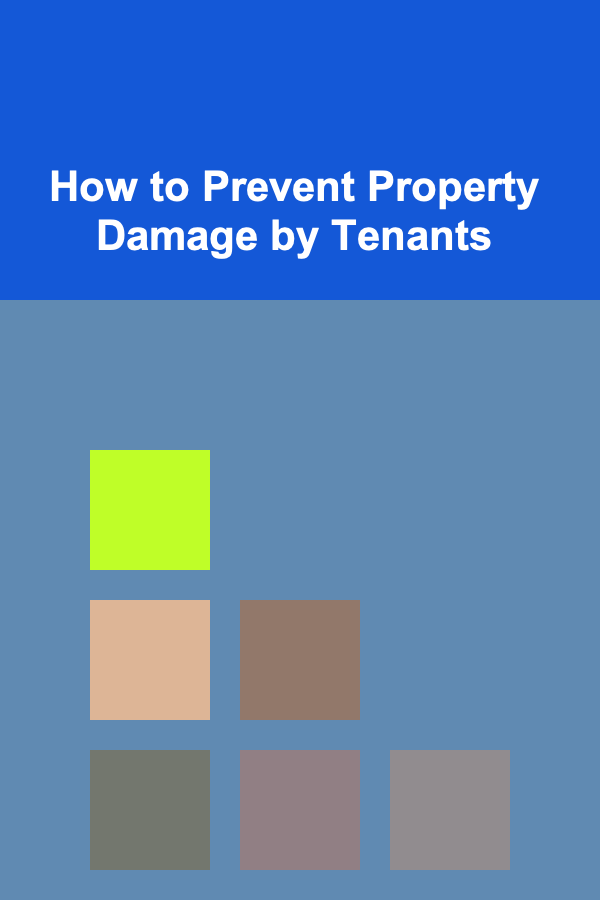
How to Prevent Property Damage by Tenants
ebook include PDF & Audio bundle (Micro Guide)
$12.99$9.99
Limited Time Offer! Order within the next:

As a landlord or property manager, ensuring that your property remains in good condition is a fundamental part of your business. Property damage caused by tenants can be a significant source of financial loss, disrupt cash flow, and result in time-consuming repairs. Beyond the immediate repair costs, damaged properties can also lead to decreased tenant satisfaction and, in some cases, legal disputes. Understanding how to prevent property damage by tenants is crucial for maintaining the longevity of your investment and ensuring a harmonious relationship with your tenants.
In this article, we will explore comprehensive strategies to prevent property damage, ranging from tenant screening processes to clear communication, regular inspections, and more. By the end of this piece, you will have a deep understanding of how to protect your property, minimize damage, and create an environment where tenants respect the property they rent.
Understanding the Causes of Property Damage
Before diving into preventive measures, it's essential to understand the common causes of property damage by tenants. Identifying these causes allows you to focus on areas that require attention and preventative action.
1. Negligence and Carelessness
A lack of care and responsibility is one of the leading causes of property damage. Tenants may fail to maintain the property properly, leading to wear and tear that could have been avoided with basic upkeep. For instance, neglecting to report leaks or not cleaning regularly can result in larger issues like mold growth or water damage.
2. Unapproved Alterations or Renovations
Some tenants may decide to make alterations to the property, such as painting walls, installing new fixtures, or even renovating rooms, without seeking approval from the landlord. These changes can lead to unexpected damage, from holes in walls to improperly installed fixtures that may cause further damage to the structure.
3. Improper Use of Appliances and Fixtures
Improper use of appliances, plumbing, and electrical fixtures can cause significant damage. For example, overloading washing machines or dishwashers, using a stove improperly, or pouring grease down drains can cause malfunctioning or clogs. Tenants may not always be aware of the right way to handle the appliances or fixtures in the rental, resulting in unnecessary damage.
4. Pets
While pets can bring a lot of joy to tenants, they can also contribute to property damage. Pets, particularly dogs and cats, may scratch furniture, chew on baseboards, or stain carpets. Additionally, pet urine can cause odors, stains, and even long-term structural damage if not properly cleaned and managed.
5. Pest Infestations
Pests such as rodents, termites, and insects can also damage property. While pests can invade properties due to a variety of factors, tenants' failure to properly store food, seal cracks, or clean regularly can exacerbate the situation. Pest infestations can lead to significant damage to walls, insulation, wood structures, and even electrical wiring.
6. Misuse of HVAC Systems
The HVAC system in a rental property is crucial for tenant comfort, especially during extreme temperatures. Misuse of the system, such as failing to change filters regularly or using it inefficiently, can lead to breakdowns, higher energy bills, and damage to the system. In some cases, improper use can result in leaks, mold growth, or air quality issues.
Steps to Prevent Property Damage
1. Tenant Screening and Selection
One of the most effective ways to reduce property damage is to ensure that you choose responsible, reliable tenants during the application process. A thorough tenant screening process can help you identify tenants who have a history of taking care of properties and adhering to lease agreements.
Key Screening Factors:
- Credit History: A tenant's credit score can provide insight into their financial responsibility. A history of late payments or poor credit management may indicate that a tenant will neglect rent payments or property upkeep.
- Rental History: Check the applicant's past rental history by contacting previous landlords. This gives you an idea of how they treated their previous living spaces and whether there were any complaints regarding property damage.
- Criminal Background Check: A criminal background check is important to ensure that potential tenants don't pose a risk to the property or other residents. While criminal history doesn't directly relate to property damage, tenants with violent or reckless criminal backgrounds might be more prone to damaging the property.
- References: Personal or professional references can provide insight into the applicant's character. A reliable reference can help you gauge whether the person is responsible enough to care for your property.
2. Clear and Detailed Lease Agreement
A well-written lease agreement sets the foundation for preventing property damage by clearly outlining both the landlord's and tenant's responsibilities. A comprehensive lease agreement should include provisions for:
Property Maintenance:
- Tenant's Responsibilities: Clearly specify the tenant's responsibility for routine maintenance tasks, such as changing lightbulbs, replacing air filters, and reporting any damage or needed repairs.
- Landlord's Responsibilities: Define the landlord's duties, such as repairing structural issues, maintaining the plumbing, and ensuring the property meets safety standards.
Alterations and Renovations:
- No Unapproved Modifications: Include a clause that prohibits tenants from making any alterations to the property without prior written approval. This helps prevent unapproved modifications like painting, installing fixtures, or removing walls.
Pet Policies:
- Pet Guidelines: If pets are allowed, specify the type of pets, any additional pet deposits, and the tenant's responsibility for cleaning up after their pets. You may also want to include clauses about pet damage, such as scratches on furniture or carpets.
Damage Reporting:
- Timely Damage Reporting: Tenants should be obligated to report any damage immediately upon discovery. This helps prevent small issues from becoming bigger, more costly problems down the line.
3. Educate Tenants on Property Care
Many tenants may not be familiar with the best practices for maintaining a rental property, so educating them can go a long way in preventing property damage.
Welcome Packet:
Provide a welcome packet that includes:
- Property Care Guidelines: Clear instructions on how to use appliances, maintain HVAC systems, and care for the floors, walls, and windows.
- Safety Procedures: Steps for handling emergencies, such as what to do in case of a water leak, power outage, or fire.
- Maintenance Schedule: A list of recommended maintenance tasks, such as changing air filters, cleaning gutters, and checking smoke detectors.
Regular Communication:
Maintain open communication with tenants throughout their lease term. This includes sending reminders about routine maintenance, offering guidance on proper use of appliances, and checking in periodically to see if there are any concerns.
4. Regular Inspections
Performing regular property inspections is a proactive approach to identifying issues before they escalate into major problems. Inspections allow you to spot early signs of damage, misuse, or neglect, giving you the chance to address them immediately.
Inspection Frequency:
- Move-In and Move-Out Inspections: Conduct a detailed inspection when tenants first move in and when they move out. This establishes a baseline for property condition and helps ensure that tenants are accountable for any damage that occurs during their tenancy.
- Routine Inspections: Schedule periodic inspections (e.g., every six months) to check for signs of damage, maintenance issues, and cleanliness. Always provide tenants with advance notice before entering the property for an inspection.
5. Prompt Repairs and Maintenance
Addressing maintenance issues promptly can prevent small problems from turning into major damage. If a tenant reports an issue such as a leaky faucet, a clogged drain, or a broken appliance, address the issue quickly to avoid further damage to the property.
Preventive Maintenance:
- Regular HVAC Maintenance: Have the HVAC system serviced annually to ensure it functions correctly and remains in good working order.
- Pest Control: Arrange for regular pest control services to prevent infestations and the damage they cause.
- Plumbing Checks: Regularly check plumbing systems for leaks and signs of wear. A small leak that goes unnoticed can lead to significant water damage over time.
6. Security Measures
While security is primarily about protecting tenants, it can also help prevent property damage caused by theft, vandalism, or unauthorized access. Implementing security measures, such as installing security cameras in common areas or providing a secure entry system, can deter tenants from causing damage.
7. Security Deposits
A security deposit is a financial safety net that can help cover repair costs in the event of property damage caused by tenants. Ensure that the deposit is sufficient to cover potential damage but remains within the legal limits set by local regulations. Clearly explain to tenants the conditions under which they could lose part or all of their deposit.
Conclusion
Preventing property damage by tenants requires a multifaceted approach that includes tenant screening, clear lease agreements, regular inspections, and ongoing education. By establishing responsible tenants, setting clear expectations, and addressing issues proactively, landlords can minimize the risk of property damage and ensure their properties remain in excellent condition.
At the core of all prevention efforts is communication. Engaging with tenants and fostering a respectful, cooperative relationship can go a long way in maintaining the integrity of your property. With the right systems in place, landlords can ensure their rental properties continue to be profitable, well-maintained, and protected from unnecessary damage.
Reading More From Our Other Websites
- [Organization Tip 101] How to Utilize Drawer Organizers for Small Items
- [Organization Tip 101] How to Set Up a Library that Adapts as Your Collection Grows
- [Weaving Tip 101] Troubleshooting Common Weaving Mistakes and How to Fix Them Efficiently
- [Home Pet Care 101] How to Identify and Treat Common Pet Health Issues at Home
- [Organization Tip 101] How to Make a Time Capsule for Milestone Birthdays
- [Personal Care Tips 101] How to Incorporate Aftershave Into Your Morning Routine for a Boost
- [Personal Care Tips 101] How to Build a Strong Core for a Healthy Back and Overall Wellness
- [Home Staging 101] How to Stage a Garage for a Clean and Functional Look
- [Home Budget 101] How to Make Small Changes Around the Home to Save Big
- [Personal Financial Planning 101] How to Create a Budget That Actually Works: Simple Tips for Success

How To Observe Lunar Eclipses: A Complete Guide
Read More
How to Organize Your Kitchen for Better Storage Efficiency
Read More
How To Take Effective Breaks for Sustained Energy
Read More
How To Save Money While Traveling Long-Term
Read More
How To Discover Series with Exceptional World-Building
Read More
10 Tips for Account Managers to Improve Client Retention
Read MoreOther Products

How To Observe Lunar Eclipses: A Complete Guide
Read More
How to Organize Your Kitchen for Better Storage Efficiency
Read More
How To Take Effective Breaks for Sustained Energy
Read More
How To Save Money While Traveling Long-Term
Read More
How To Discover Series with Exceptional World-Building
Read More